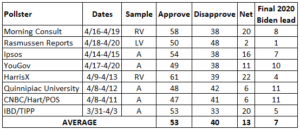Washington Post columnist E. J. Dionne, Jr. writes, “A majority of Trump’s loyalists — the most fervent Republicans, ardent immigration foes, hard cultural conservatives, gun rights zealots, racial backlash voters — will never be available to Biden or the Democrats. But Biden is banking on his ability to use populist economics (relief checks, upward pressure on wages, a “Buy America” campaign to bring home more manufacturing work, confining tax increases to corporations and those earning more than $400,000 annually) to win back Trump voters whose dissatisfactions are primarily economic….Biden’s proposals have thus far won support in the polls from about a third of Republicans and a substantial majority of lower-income Republicans (in the case of the relief act). Their response has allowed Biden to challenge the traditional definitions of bipartisanship — House and Senate Republican votes for his bills — that hamstrung his predecessors. Instead, Biden argues that what he is doing is good for many Republican voters, and that a significant share of them agrees….As a result, Biden has contained hostility to his administration and left Republicans with few easy lines of attack. In polls conducted this month by Reuters/Ipsos, Economist/YouGov and Politico/Morning Consult, Biden’s approval rating averaged 54 percent. But perhaps more revealing, his disapproval rating averaged just under 40 percent. A Post/ABC News Poll released Sunday put approval of Biden at 52 percent, disapproval at 42 percent. In this very polarized era, not being hated is a major political achievement….Because Biden is focused on what pollsters see as less divisive “kitchen table” issues, he has been able, so far, to propose a great deal of spending and take steps progressives have long supported without running afoul of more moderate opinion….Republicans have challenged his broad definition of “infrastructure,” arguing that expanded child care and elder care do not fit into traditional definitions of the word. But, in both cases, Biden has again stressed the job-creating, income-generating aspects of his initiatives. They also happen to be popular with families with all manner of political views, particularly those with two earners working outside the home….Biden’s pandemic-plus-the-economy focus has had downsides, notably in his recent mishandling of caps on refugee admissions. He clearly fears that Republicans are gaining traction on immigration. Despite the political challenges, dealing with it comprehensively remains a far better course than a series of defensive postures. And progressives are looking for more from him on health care and a permanent child tax credit expansion….But the man who addresses the nation on Wednesday clearly knows what his presidency is about. And he can have confidence that his political strategy and the substance of what he is doing are mutually reinforcing.”
At The Cook Political Report, Charlie Cook observes that “Democrats sense a key structural advantage that they hope has them set up for season after season of success: Their party is growing in precisely the sectors of the country that are prospering and best positioned for the future; by contrast, they see the Republican Party strongholds as scared of the future and shrinking in population, economic growth, and influence….Days after the November election, a Brookings study showed that the 2,586 counties that Donald Trump carried represented only 29 percent of gross domestic product, while the 527 counties that Joe Biden won made up the other 71 percent….The Economic Innovation Group, a bipartisan think tank funded by Silicon Valley, found recently that those same Biden counties were home to 83 percent of the new firms started between 2010 and 2018, the longest period of sustained peacetime economic growth in U.S. history, and 73 percent of the employment growth during that period. Its report also found that “from 2010 to 2019, the number of people in counties won by Biden grew by an average of 3.1 percent over the period, while the counties won by President Trump averaged an increase of just 0.6 percent.””
In “Americans From Both Parties Want Weed To Be Legal. Why Doesn’t The Federal Government Agree?” at FiveThirtyEight, Dhrumil Mehta notes “Gallup has asked Americans about whether they support legalizing marijuana since 1969, when only 12 percent of Americans supported the idea. As of their most recent poll last November, that number has ticked up to 68 percent, the highest level of support on record. And perhaps unsurprisingly, the number of states where recreational marijuana is now legal has also steadily increased since the Obama administration announced in 2013 that it wouldn’t block state laws that legalized the drug, provided that marijuana was strongly regulated….Thirteen of the 18 states where marijuana is legal have done it via voter-driven ballot initiatives rather than legislation. That said, legalization is broadly popular even in more Republican-leaning states like Florida, Louisiana, North Carolina and Texas….More than one in three Americans live in states where marijuana is already legal for recreational use, and a sizable majority live in states where marijuana is legal for medical use.”
From “Other Polling Bites,” also at FiveThirtyEight: “A special election in Texas’s 6th Congressional District will take place on May 1 to fill the seat of Republican representative Ronald Wright, who died from complications of COVID-19 in February. And a poll by Meeting Street Insights for the Washington Free Beacon shows no candidate anywhere close to the 50 percent needed to win outright, which means the race will likely go to a runoff. Democrat Jana Lynne Sanchez leads in the poll with 20 percent of the vote, followed by Republican candidate Susan Wright, the widow of the congressman who previously held the seat, who received 17 percent. Two other Republican candidates polled in the double digits: Jake Ellzey, a current state representative, and Brian Harrison, a former Trump administration official, earned 16 percent and 12 percent support, respectively.”




